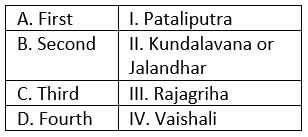Test: Religious Movements- 1 - Delhi Police Constable MCQ
30 Questions MCQ Test - Test: Religious Movements- 1
Who among the following was the first to become a Buddhist nun?
Which of the following works of Mahayanism is a flowery account of the life of Buddha?
Mahayana Buddhists are credited, rather discredited, with starting the practice of idolworship for the first time in India. When did they began this practice?
At which of the following councils was the “Abhidhamma Pitaka” written for the first time?
Which is the CORRECT historical sequence for the rise of the following Buddhist sects?
I. Sthaviravadin
II. Sarvastivadin
III. Mahayanists
IV. Vajrayanists.
Arrange the following chronologically:
I. Nalanda University
II. Vikramsila University
III. Taxila University
IV. Valabhi University
V. Nagarjuna University
Arrange the following important personalities of Buddhism in the CORRECT sequence:
I. Nagasena
II. Vasumitra
III. Ananda
IV. Moggaliputta Tissa
Arrange the following places connected with Jainism in the chronological order:
I. Pavapuri
II. Valabhi
III. Pataliputra
IV. Kundagrama.
Which of the following factors were responsible for the origin of the Buddhist tradition?
Which of the following statements regarding Buddha is WRONG?
Who were the first teachers of the Buddha, after his great renunciation?
Which one of the following is NOT considered to be a great event in Buddha’s life?
On the basis of which of the following traditional records the dates of Buddha’s birth and death have been fixed?
Match the Buddhist Councils and the places where they were held:

Match the names of Presidents of the Buddhist Councils:

Milinda of the well-known Pali text ‘Milinda Panho’ had dialogues with one Buddhist priest.Name the priest.
What were the important causes of the spread of Buddhism in India?
A. Simple teachings in the language of the people.
B. Royal patronage.
C. Support of the trading community.
D. Role of Buddhist monks and monasteries.
Which statement on the history of Buddhism is NOT correct?
Who was the founder of the Theraveda sect of Buddhism?
Who was the founder of the Mahasanghika sect of Buddhism?
Which of the following is NOT a feature of Mahayana Buddhism?
Which of the following events of Buddha’s life is known as Mahabhinishkramana?
The third Buddhist Council was held at Patliputra, during the reign of Ashoka, 236 years after the death of Buddha to revise the scriptures. Which of the following Pitakas was added to the existing two in this Council?
According to the Buddhist traditions the four great signs transformed the life of Gautama.Which one of the following is known as the ‘Four Great Signs’?
Which of the following is NOT one of the ‘Four Noble Sentiments’ that a person aspiring for nirvana should cultivate?



















